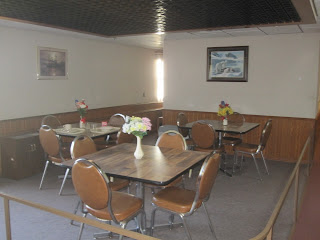JULY 4TH 2013
There have been many periods of time in our country's existence that are vividly etched in our minds. One such period for me is the Cold War era.
This era, which started right after World War II, escalated until it's peak in the late 60's and early 70's. I remember having practice drills in school. Yes, I grew up in the 60's - I'm really that old. The Nuclear Age kept us all wondering at times. Would the Soviets really launch missiles to annihilate us? Could we defend ourselves against the Russians?
Missiles, especially those with long range capability like the ICBM and IRBM were an integral part of our defense in those years. It was during that time that the US constructed hundreds of missile silos across the northern states of Montana, North Dakota, and South Dakota to defend our nation against such attacks and to give us the strike capability into the Soviet Union as a deterrent.

Looks pretty benign, doesn't it? In it's day, this site could unleash a barrage of death and destruction on unsuspecting citizens of the Soviet Union or any other target designated by the President. This site is now decommissioned and sits abandoned in central North Dakota.

Our Destination! The missile alert facility was separated from the actual launch silos by miles, and each Alert Facility controlled more than one launch facility.
The facility is pretty much the same today as it was when the Air Force decommissioned it in 1997 as a result of the START agreement with Russia.
One of the funny stories we heard was about the isolated launch facilities. It seems that the facilities, which were only equipped with motion detectors, were often the object of "attack" by young local girls who would toss rocks into the facilities so the cute young Air Force guys would come check out the disturbance and they could flirt with them. There were numerous marriages that resulted!
This is the Day room area where the airmen could spend any down time. They rotated through here from Grand Forks AFB. The above ground personnel served 3-day rotation here while the below-ground personnel were only here for a 24 hour shift. The underground personnel had to go below ground immediately upon arrival and didn't come up until the end of their rotation.

Sleeping quarters for above-ground personnel.
Eating area.

This is the area where the below ground personnel spent their time. Other than the two consoles from which they could unleash nuclear fury, there is a bunk to rest, a microwave for heating food and a TV that was installed in early 80's. That's pretty much their world while below ground.
The famous box that contained the launch keys. It had two locks that could only be opened by the personnel on duty. each set of personnel brought their own locks that the USAF assigned them.
One of "the keys" needed to launch.

The names of those on duty the last day the facility was occupied by the USAF.

Our Destination! The missile alert facility was separated from the actual launch silos by miles, and each Alert Facility controlled more than one launch facility.
The facility is pretty much the same today as it was when the Air Force decommissioned it in 1997 as a result of the START agreement with Russia.
One of the funny stories we heard was about the isolated launch facilities. It seems that the facilities, which were only equipped with motion detectors, were often the object of "attack" by young local girls who would toss rocks into the facilities so the cute young Air Force guys would come check out the disturbance and they could flirt with them. There were numerous marriages that resulted!
This is the Day room area where the airmen could spend any down time. They rotated through here from Grand Forks AFB. The above ground personnel served 3-day rotation here while the below-ground personnel were only here for a 24 hour shift. The underground personnel had to go below ground immediately upon arrival and didn't come up until the end of their rotation.

Each site had their on kitchen and cook. But all the food listed is prepackaged and microwaved when needed.
Eating area.
Let's go below ground! That's what it looks like from 50' below the surface. But they only used the ladder (left) if the elevator quit.
Below ground, there are two "pods" or chambers: one for support equipment, and the other for the two men to occupy where all the communications and launch capabilities resided.
This chamber has all the equipment needed to survive for up to 60 days - including a self supporting oxygen system and generator!


And it's protected by this door that weighs.....wait for it......14 tons!

See how thick it is!
The famous box that contained the launch keys. It had two locks that could only be opened by the personnel on duty. each set of personnel brought their own locks that the USAF assigned them.
One of "the keys" needed to launch.

The names of those on duty the last day the facility was occupied by the USAF.
We finished the day cooking burgers on the grill and watching the fireworks! What else? We're celebrating a birthday!















No comments:
Post a Comment